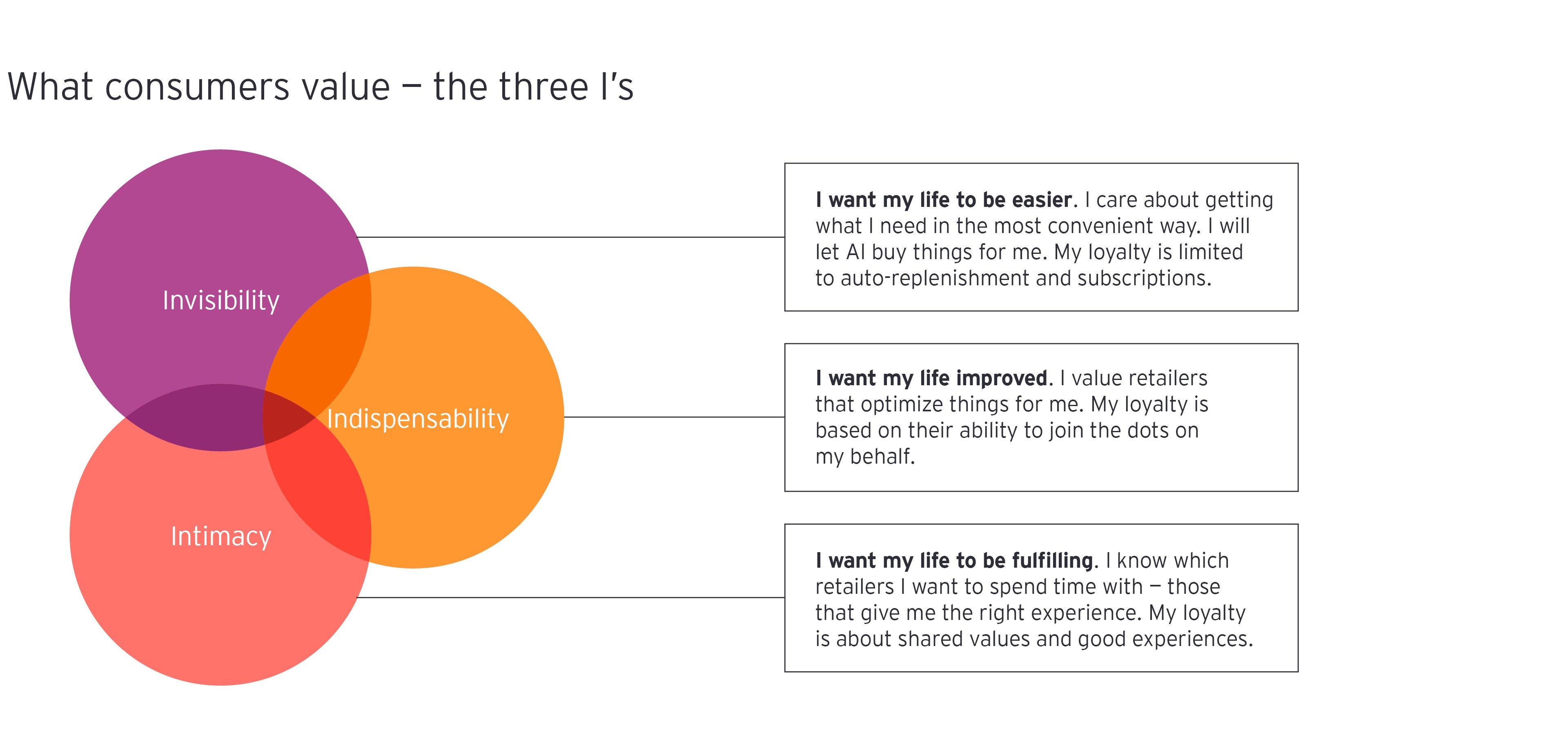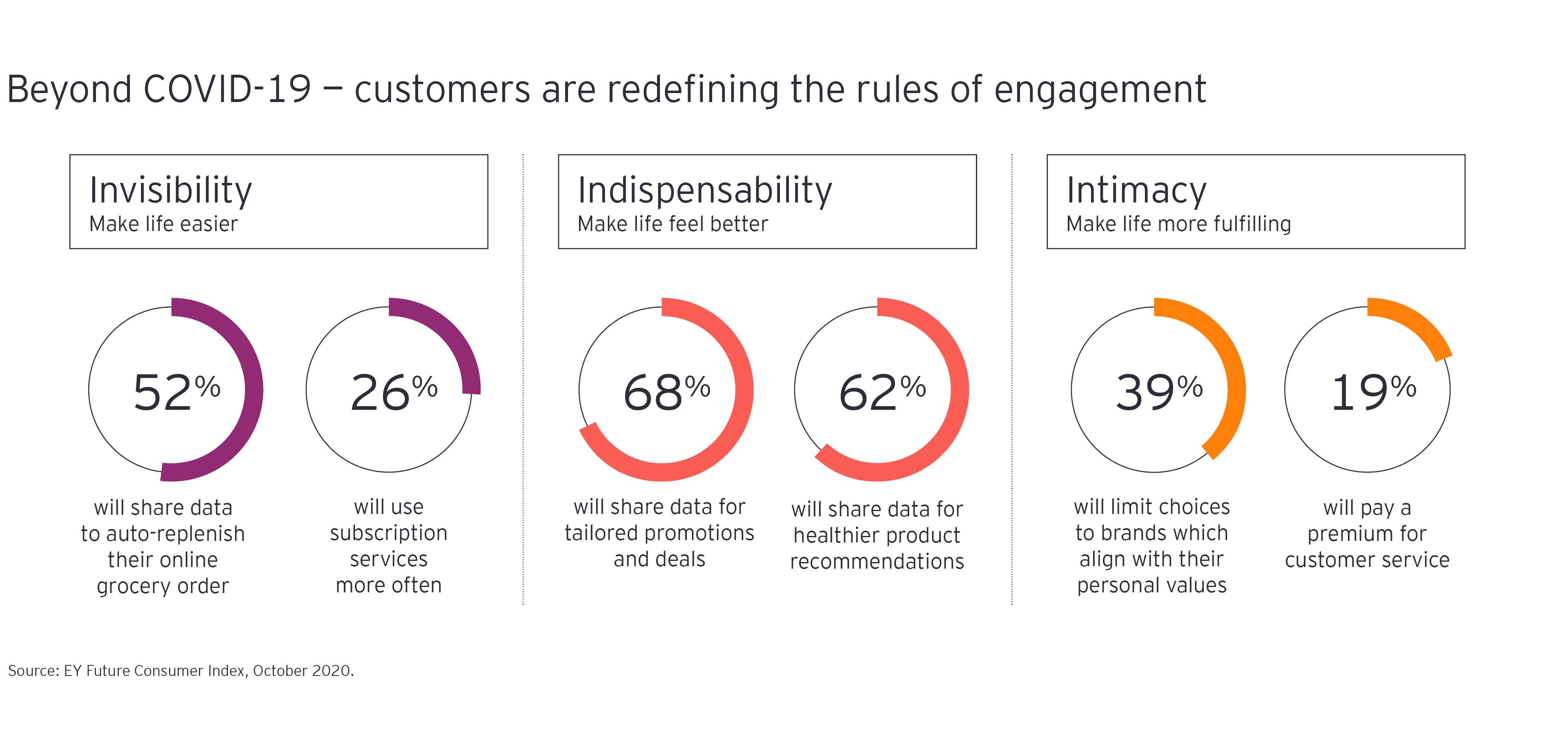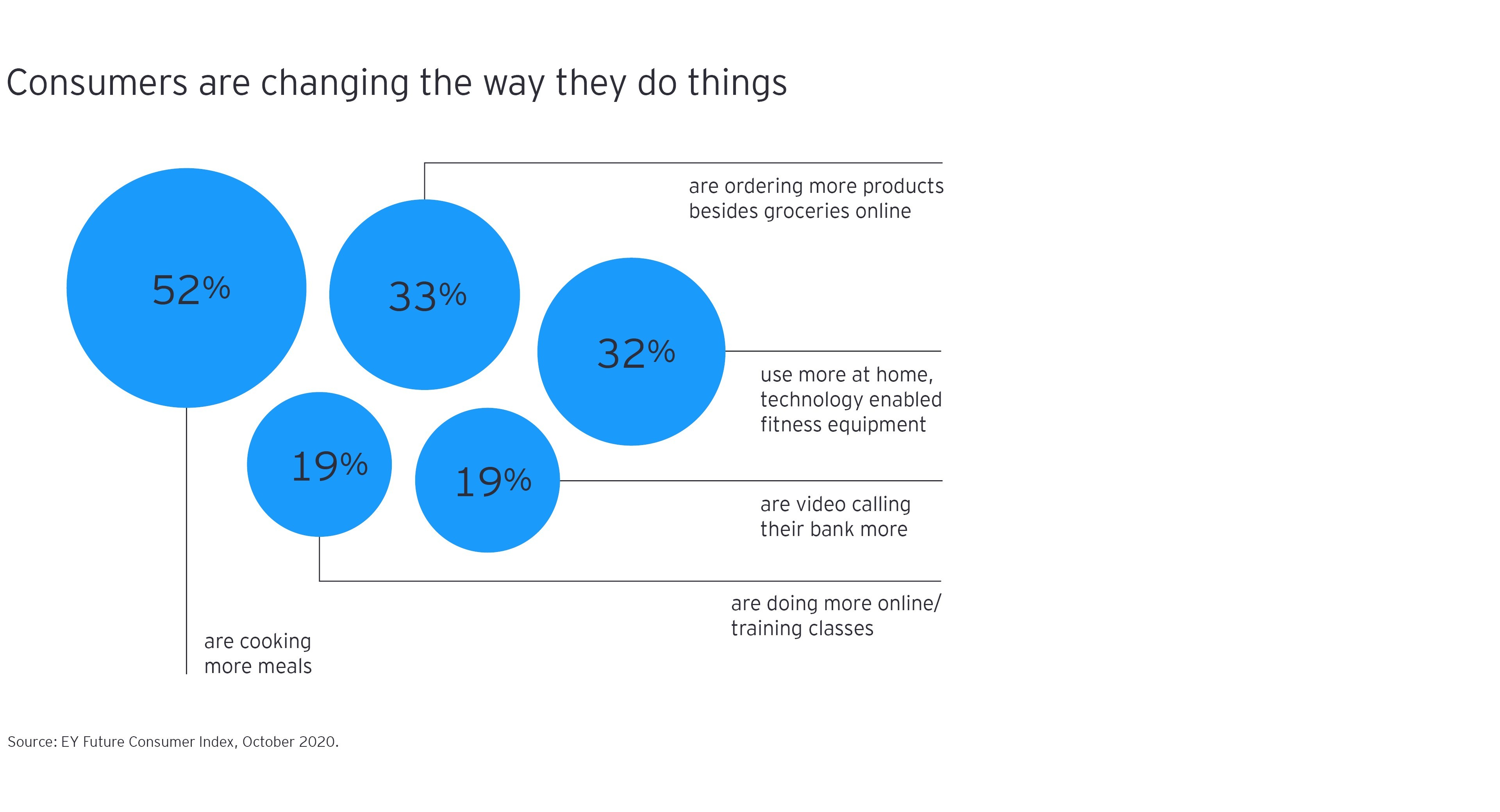
Chapter 1
It’s not enough to be customer centric
Customers are looking for retailers to make life easier, make life feel better and make life more fulfilling.
The relationship between retailers and customers is changing fundamentally, with power and control shifting to the customer. This is something we’ve been exploring and modelling via our FutureConsumer.Now program since 2018. One implication for retail is that the shopper increasingly expects to do business with companies that are simply “there for me” when needed. Retailers can no longer expect the customer to come to them; they have to go to where the customer is. In many cases, that location is online.
Even before COVID-19, consumers were living their lives more digitally, whether to work, learn, socialize, shop or be entertained. At the same time, retail has been diverging into two different forms of interaction. There is “buying”, which is about making transactions seamless in order to save time, and there is “shopping”, which is about giving the customer an experience that they want to spend time engaging with. As COVID-19 restrictions have forced physical outlets to close, both kinds of retail – buying and shopping – have moved increasingly online.
The shopper increasingly expects to do business with companies that are simply “there for me” when needed. Retailers can no longer expect the customer to come to them; they have to go to where the customer is.
This move to online has changed what “convenience” means to the customer and what kind of “experience” the customer wants, but their underlying desire for convenience and experience is still there. We feel it’s useful to think in terms of three core customer expectations: make my life easier, make it feel better, or make it more fulfilling. These expectations create three areas of opportunity for a retailer to become an integrated part of the customer’s life: become invisible, become indispensable, or become an intimate part of their life experience (just someone the customer wants to spend time with).
The three I’s are not mutually exclusive. The challenge is to shape a proposition that delivers value across more than one of them, and to deliver it in a way that competitors can’t match.

Integrating to create a deeper connection
There are retailers today that are highly skilled at giving each customer the right mix of invisibility, indispensability and intimacy. They make it easy for the consumer to shop online from home, using AI-supported repeat purchase lists and convenient delivery; to listen to music (on subscription) via an omnipresent digital assistant; to enjoy fun cook-along sessions in their own kitchen (having ordered the ingredients to be delivered); and to watch whatever film the family fancies (downloaded from the cloud).
They can guide and shape the customer’s choices, consciously or unconsciously, and build deeper connections through services that go beyond selling a product, such as education, health and advice. And they can engage the customer in moments, places and channels beyond “the store”, such as the social platforms the customer is using already, the hotels they choose to stay in, and the events they like to attend.
Retailers like these are inside the customer’s circle of trust – they are among the few organizations that the customer is happy to accept into their lives. The more the consumer feels and appreciates the value delivered, the more opportunities they will allow the retailer to deepen and widen the relationship. Over time, potentially, their loyalty will grow and they will buy more. This isn’t about the retailer locking-in its customers. If you are inside the circle, you can redefine your relationship with that customer. But the only way into the circle is for the customer to invite you.
It’s difficult to build and sustain this kind of relationship when competitors are constantly raising customer expectations, especially at a time of extreme uncertainty and financial stress. But it’s possibly the only option for retailers that want to exist at scale.

Chapter 2
How will you give customers something they truly value?
Shape a relevant proposition by mixing three elements: the time saver, the problem solver and the experience creator.
Few retailers can embed themselves successfully into the life of every customer. The challenge is to understand what the customer really wants, to shape a value proposition that is right for that customer, and then deliver it with the right experience, assortment and price, and at the right time.

To be credible, that new proposition needs to be rooted in the retailer’s core identity. But to unlock new opportunities to create value within the retail sector, leaders need to build beyond what worked in the past. By tailoring their offer so it creates value that is right for both the customer and the retailer, they can build relevance and trust.
The three opportunities to become more integrated into the customer’s life (invisibility, indispensability and intimacy) map to three value propositions: save me time, solve my problems and give me an experience I value. A compelling and differentiated proposition will give the customer the ideal mix of all three:
1. The time saver
This proposition is about becoming an essential part of the customer’s life by making what you do almost invisible. The focus is on giving the customer what they want, quickly, conveniently and efficiently. Leading “time savers” are adept at using automation and digital capabilities through a variety of channels and models. They deliver high volumes at a low margin, with a product assortment, property portfolio, digital infrastructure and logistics that are designed to minimize friction. They use fulfilment models such as subscription and auto-replenishment to pre-emptively curate the customer’s needs and tastes. For example, a grocer connected to IoT in your fridge knows when you’re running low and what to restock.
2. The problem solver
This second proposition is about becoming an essential part of the customer’s life by making what you do indispensable. The focus is on creating bundles of goods and services that meet the customer’s needs in a holistic way. The best “problem solvers” are brilliant at delivering outcomes. They curate, combine and orchestrate goods and services from a broad ecosystem of partners. They often provide goods and services at zero margin, but as part of higher margin service offerings. For example, a company that links the nutritional profile of the groceries they sell to you to the health insurance premium they provide.
3. The experience creator
The third and final proposition is about becoming an essential part of the customer’s life by creating an experience rooted in intimacy. The focus is on providing enriching experiences that delight the customer to such an extent that shopping becomes a meaningful and satisfying leisure activity. For companies that are great “experience creators”, the product is secondary to the service and experience that surrounds it. They win when they create digital and physical spaces that their customers want to spend time in, and when there’s a sense of shared values between the retailer and the customer. They create a sense of intimacy by optimizing every interaction and service experience around the individual customer. This isn’t just about premium brands and luxury; a compelling shopping experience can be anything that the customer enjoys doing, including browsing for bargains. For example, a retailer that hosts social events and generates revenue from the merchandise it sells.
Value in an ongoing relationship
Whatever new proposition a retailer defines, it must be able to flex in ways that create value for the customer in an ongoing relationship, beyond point of sale. But it’s important to always be right for the context, otherwise you risk becoming unwanted “noise.” For example, can a food retailer dial up the “time saver” part of its proposition when a customer is looking to pick up a quick meal for the family, then become more of a “problem solver” when a customer wants advice on the right wine to serve? Or can it shift gear to become an “experience creator” by providing inspiration through online cookery classes and recipes? Achieving all of these might be impossible and retailers cannot be all things to all people. Instead, they must find the right blend of model and formats to deliver to their strengths.

Chapter 3
What does it take to enrich a consumer’s life?
Moving from where you are now to where your customer wants you to be.
These are deeply challenging times for retailers, but those that rethink what they offer the customer can become more valued by them. However, they’ll need to change the way they do business, develop new capabilities, and move quickly and decisively. For many, curating and selling others’ products will mean finding a unique differentiator, owning the full value chain or becoming part of a digital or broader ecosystem.
Three opportunities to build relevance:
1. Listen to your customers: understand what they want and when they want it
A critical first step to being considered a trusted retailer is to focus on the customer segments that share your values and buy into your promise. Retailers that try to be all things to all people in the hope of pleasing everyone risk delighting no-one.
Retailers can actively listen to their customers and better identify their needs by building a 360° perspective that encompasses the end-to-end customer journey, from product discovery through to after-sales service. Acceptance into the customer’s circle of trust starts with these insights. They give retailers the opportunity to be present and appealing in the micro-moments that matter to the customer.
By integrating what they learn back into their business, retailers can shape and improve what they choose to present to the customer. They can go beyond simply providing personalized promotions and drive deeper customer satisfaction. Also, they can use these data insights to inform operational decision-making in areas such as assortment, replenishment and supply chain. This will create a virtuous circle that delivers value to the customer and to the business.
2. Invest or partner to be wherever your customer is whenever they need you
Facing unprecedented change, retailers must find new ways to meet customer needs at scale and speed. Not all the required capabilities can be built in house.
Competition for share of attention will intensify as more companies seek to become part of their customers’ lives. To gain trust, retailers need to make better decisions faster. They need to find timely and effective ways to engage or enrich the customer, in digital and physical spaces beyond their own store or app.
Retailers can develop or join networks of like-minded partners to gain faster access to new tools, platforms, skills, services, products, markets and customers. They can also invest in third parties. To stay relevant to the consumer, all parties must trust each other, understand the contribution they each make, and deliver to expectation. They will need to share actionable data that provides clear visibility on what’s working and what needs to improve.
3. Become a truly data-led business
Customers expect a seamless omnichannel experience that blends the physical and digital. To remain in a circle of trust, retailers must know them well and engage them in ways that feel relevant. But it’s hard to make holistic business decisions when you are hampered by operational and channel silos.
Retailers need to connect every part of their business so they can use data in real time and link the customer journey with suppliers, partners and the rest of the business. It will often take a company-wide rethink of technology infrastructure to create a central and universal data pool. Every area of the business should be involved.
Unsurprisingly, some retailers are hesitant to leverage new technologies and the disruption that comes with them. However, they can provide transformative opportunities to deepen the relationship between retailer and customer. Those with strong analytics capabilities will be in the best position to empower their staff with data. They can then use these insights – and add a human touch – to improve individual customer experience. With the right technology platform in place, a data-savvy retailer can measure the success of their value proposition and improve profitability.
Some retailers are in a better position to make this pivot than others, and many are primarily concerned with navigating the current situation. Those that were changing before COVID-19 have outperformed their rivals. But when other companies are continually raising customer expectations, nobody can afford to be complacent. Those that have been slow to change because they are constrained by their legacy now have little choice. They urgently need to make themselves relevant, especially those that have a significant store presence or depend on selling other companies’ products.
But all retailers need to rethink their proposition. The customer is changing faster than ever and retailers that do not change with them risk irrelevance. However, these disruptive times could provide opportunities for retailers to create deeper, more profitable, relationships with the people they serve by better integrating into their lives.
Related articles
Summary
With COVID-19 accelerating deep changes in how people shop and what they buy, retailers must shape new propositions that will be relevant now and into the future. This will involve moving beyond their traditional definitions of customer centricity to become truly integrated into the life of the customer by addressing three underlying consumer needs: make my life easier, make it feel better, make it more fulfilling. To achieve this, retailers must develop their value proposition to deliver the right blend of saving time, solving problems or creating experiences for their customers.


